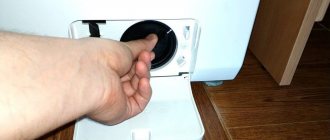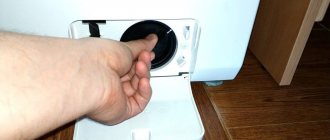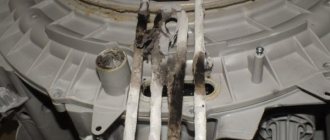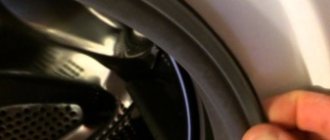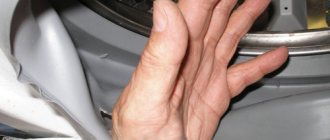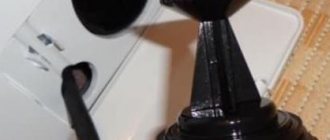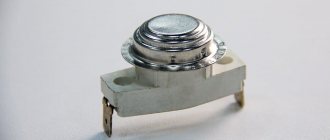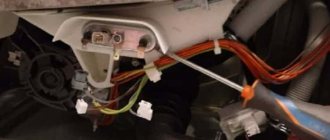During operation, scale forms on the elements of the washing machine.
This occurs due to the release of limescale deposits from the water when heated. The rate of sediment formation is affected by the intensity of use, frequency of washing at high temperatures, and water hardness.
High-quality regular cleaning helps to cope with the problem. To learn how to remove scale from an automatic washing machine at home, read the article.
When to clean your automatic machine?
Descaling your washing machine should be done periodically. This will avoid voluminous accumulations that impair the operation of the device and contribute to equipment breakdowns.
The visible part of the drum, into which things are placed for washing, almost always looks shiny and clean . But this circumstance has nothing to do with the condition of the heating element and the outer part of the drum.
The recommended cleaning frequency is once a quarter; if you use the washing machine very rarely, it is a couple of times a year. The hardness of the tap water affects how often preventative maintenance should be performed.
If the water in the system is hard, and washing is carried out mainly on a long cycle with high water heating, cleaning of lime deposits should be carried out more often, once every 2 or 2.5 months.
More frequent cleaning than recommended with special or folk remedies can accelerate the wear of rubber and other parts of the washing machine.
How to clean an elastic band in the washing machine
Mix bleach with warm water in a 1:1 ratio, wet the fabric and wipe all internal surfaces. If the dirt is very strong, leave the cloth soaked in the solution for half an hour. After this, brush it again with a toothbrush.
On the Internet you can find numerous videos with tips on caring for a washing machine, here is one of them from an experienced housewife.
Regularly performing these simple steps to clean and care for your washing machine will allow you to improve the quality of your wash and extend the life of your washing machine. Don't forget to share these secrets with your friends, they will be grateful for them!
Use of special means
In addition to simple home recipes, you can use special household chemicals for descaling. Such products do not harm the washing machine itself and effectively remove lime deposits. It is necessary to use household chemicals for descaling strictly according to the instructions for the product.
MAGIC POWER
To clean the elements of the washing machine that come into contact with water and are prone to scale build-up, you can use the German product MAGIC POWER. The product is produced in Germany.
There are two release forms:
- gel;
- powder.
Application is not difficult. If a gel is selected, the procedure is as follows:
- Pour ½ to 1 bottle of product into the washing machine.
- Start washing at +60°C.
The powder is effective, due to the acids it contains, even at a temperature of +40°C. How to use the powder:
- Pour the powder into the washing powder compartment according to the instructions.
- Set the washing mode by adjusting the temperature.
- Start the wash.
The cost of the product depends on the form of release. For gel it’s 200 rubles per half-liter bottle, for powder – from 100 rubles per half-kilogram pack.
Topperr Express Cleaner
TM Topperr powder is intended for removing scale from washing machines and dishwashers. The drug is produced in small packages weighing 125 grams. Price for 1 pack – from 200 rubles.
Using this powder is very simple. Pour the entire pack directly into the drum and start washing at a heating temperature of +60°C.
Dr. Beckmann
The product is available in liquid form . In addition to removing scale, the drug helps eliminate mold and unpleasant odors.
The cleaner is poured into the powder compartment and the wash is started at +60°C. A container with a volume of 250 grams costs from 300 rubles.
Mechanical impact
Manual cleaning of the heating element is also an effective procedure for removing hardness deposits, but the method requires disassembling the household appliance and having certain knowledge and skills.
Cleaning process:
- disconnect the wires, sensor, remove the tubular element;
- rinse the heating element under the pressure of hot water, remove the top, loose layer of dirt with a hard sponge;
- cut off the neck of a plastic bottle, pour 4 tablespoons of citric acid into it and place a heating element in the container, fill it with hot water to the level of the stop bar;
- shake the bottle several times and leave it for 8-10 hours;
- After the time has passed, remove the part and rinse it with water, while simultaneously cleaning the surfaces with a soft sponge from any remaining deposits.
IMPORTANT!
It is unacceptable to remove solid sediment from the part with a file, sandpaper, or knife - metal objects can damage the surface of the heating element.
Traditional recipes or special remedies?
FolkSpecial
How to clean the powder compartment?
Cleaning the washing machine must be carried out comprehensively. In this case, it is necessary to pay attention not only to the heating element, but also to the powder compartment. Deposits also form on its surface and in the niche where it is inserted.
This leads to:
- hard water;
- remnants of detergent that are not completely washed;
- air conditioner residues;
- dust and other pollutants.
Incompletely rinsed residues of powder, gel and conditioner can be easily removed in warm water using a small brush.
Work order:
- Pull the container out of the hole.
- Remove the removable part in the air conditioner compartment from the cuvette.
Rinse in water.- Using baking soda and a brush, scrub the container on all sides.
- In case of significant lime deposits, it is possible to use bleach for cleaning.
- Pour hot water into a bowl of suitable size, into which the removable container fits entirely, and dilute the packet of citric acid.
- Place the cuvette in the bowl and leave for at least 1 hour. Maybe longer. If there are significant scale deposits, the cuvette can be left soaked in citric acid for several hours.
- Clean with a brush, paying attention to all joints.
- Wipe the cuvette.
- Install the removable part for the air conditioning compartment.
- Place the cuvette in place in the grooves.
It is convenient to use an old toothbrush with a small working head to clean the container.
The video will show you how to clean the powder tray from scale and mold:
Vinegar + soda
You can use vinegar and soda against scale in trays for powders and conditioners. Just to start, you will need to remove the container. Remove the tray according to the instructions. It is included with each device; if you get lost, look it up on the Internet.
After removing the containers, soak them in a solution of vinegar and baking soda. A reaction will begin in which foam will form, which is what helps remove limescale.
The trays are left in this solution for 2 hours. Then rinse under running water, wipe dry and put in place.
Some say: “I clean with this solution, but I can’t achieve the desired result.” Vinegar and baking soda are products that are used to remove small layers of limescale. In severe cases they will not help.
You can soak the trays in this limescale-removing product once a month.
Cleaning the drain hose and filter
If cleaning is limited to just running the washing machine on a vigorous cycle (with hot water and descaling agents), the washing machine is not yet fully cleaned.
The filter and drain hose through which water leaves the device into the sewer can become clogged with various debris - lint, hair, scraps of paper and pieces of exfoliated scale.
Procedure for washing the filter:
prepare rags, a water container, napkins and brushes;- open the protective panel, which is usually located on the bottom of the façade;
- lay enough rags on the floor in this place to absorb water;
- turning the filter counterclockwise, unscrew it and remove it;
- clean it of debris and rinse it in water.
Flushing the hose is carried out as follows:
- through the drain filter, the remaining water from the machine can be drained into a prepared container, for example, into an empty jar;
- the hose is disconnected from the drain point (sewer pipe);
- Taking into account the design features, disconnect the hose and wash it.
It is recommended to clean the filter and hose at least 4 times a year, more often is better.
How to clean the filter in a washing machine, video instructions:
Vinegar
To mercilessly destroy scale, it is recommended to use vinegar. Thanks to it, you can remove even the most serious lime deposits. Vinegar is cheaper than Calgon, and more effective.
How to descale your washing machine:
- Before using any cleaning agents, you must remove all items from the device.
- Add 500 ml of table vinegar to the liquid powder tray.
- Then put on the longest wash cycle with pre-soaking. This is necessary so that the solution has a good effect on all elements.
- Always rinse the drum with clean water after completing the cycle.
The scale from the electric heater will disappear, the washing machine will become clean, like it was not even after purchase.
To clean the rubber seal, spray vinegar into hard-to-reach places using a spray bottle, wait a while and rinse with water.
Prevention of plaque
It is almost impossible to completely prevent scale formation in a washing machine. Preventive measures include the following:
- Install filters at the entrance to the house (apartment), which would purify the water from mechanical and other pollutants, and also soften its composition. One of the filtration options is a magnetic filter that can change the crystalline structure of water.
- Periodic cleaning of the washing machine from scale using one of the methods.
- Refusal to wash old items, as well as those from which lint and threads are separated. When washing, such particles quickly stick to the heating element and accelerate the formation of scale.
- Refusal to machine wash heavily soiled items - in solvents, building mixtures, etc. These substances can also stick to the heating element and contribute to the fouling of the heating element with lime.
- Frequent washing at high temperatures with a long processing cycle also contributes to the formation of scale.
The appearance of scale
The central water supply supplies fairly hard water. Its composition is filled with calcium and magnesium salts. During washing, the water heats up and its harmful substances turn into solid sediment and carbon dioxide.
The substances, together with dirty particles (pieces of rust), settle on the heating element and tank of the car. With each wash, a metal device becomes covered with a hard crust, which does not conduct heat well. Which leads to longer heating of water and higher energy costs.
When too much scale forms, this will be indicated by a sudden stop of the machine during washing or it will not turn on initially. At such a moment, many immediately turn to a washing machine repairman. However, you can save money and check the condition of the machine yourself. As a rule, the reason lies in scale on the heating element or a clogged drain pump filter.
Owners of washing machines can personally determine the presence of scale on the heating element of their equipment. To do this, you need a regular flashlight, which will be an indispensable tool in this matter. As a rule, the heating element is located under the drum or slightly shifted to one side or another.
The switched-on flashlight must be brought to the holes of the drum and try to examine the heating element. It is important to shake the drum slightly so that the light is evenly dispersed. If you fail to inspect the heating device the first time, it is important not to despair and try again.
